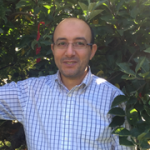By Achour Amiri, Assistant Professor of Plant Pathology, WSU-Wenatchee
Sanitation practices.
Studies have shown that the initial inoculum of pathogens at the start of the storage season has a big impact on decay development postharvest. Fruit may come already infected from the orchard with spores of several pathogens causing rots such as bull’s eye rot, gray mold and speck rot. Our previous note discussed strategies to minimize fruit infection in the orchard. However, spores of other major rots such as blue mold, cladosporium rot, and mucor rot contaminate fruit in bins at harvest or during storage. These pathogens are airborne and release spores that can remain in the air and on the walls of storage rooms as well as on the bins used during the previous season. If they are not eliminated before new crop is put into storage, these spores will cause infections on fresh wounds caused during harvest. Sodium hypochlorite (chlorine), quaternary ammonium and peracetic acid are some products used warehouse sanitations in the Pacific Northwest (PNW). Preliminary tests we conducted for two years showed an average efficacy of the above treatments in reducing the fungal populations in rooms. Ozone could be an alternative and might be easier to apply in empty rooms or filled with empty bins. Our preliminary tests using 800 ppb to 1000 ppb for 24 to 48 hours in empty rooms have shown some encouraging results in eliminating spores form the air and walls of rooms. Other studies are being conducted to fine-tune the application. Timing of sanitation may be of importance. When possible, sanitizing rooms and bins just prior to storing the new crop will avoid recontamination. In addition to minimizing fruit pathogens, sanitation practices will help with meeting food safety requirements.
Are postharvest fungicide applications necessary on fruit sprayed in the orchard?
The necessity of applying fungicide on harvested fruit that received another fungicide preharvest is a question for debate. There is no a simple answer but the necessity of postharvest application may depend mostly on the expected storage period, cultivar, and export considerations. Currently, four single-site fungicides are available for packers in the PNW (Table 1). Thiabendazole (Mertect, Decco Salt No. 19, Shield-Brite TBZ), pyrimethanil (Penbotec 400 SC) and fludioxonil (Scholar SC, Shield-Brite FDL 230 SC) and difenoconazole (Academy) are registered for drench and drip postharvest applications. Other formulations of the three first fungicides exist for dry applications (fog or aerosol). Difenoconazole, premixed with fludioxonil as Academy, has been registered in 2016 for apple and pear. Our studies have shown a high efficacy against major postharvest rots. The development of a formulation for a dry application will help overcome limitations due to waste management issues of wet formulation available currently.
Judge (FRAC group 17) is a new postharvest fungicide registered for pear only as a dip treatment or on the packing line. Judge has a different mode of action but is only active against gray mold and no a formulation for dry application is available at this time. Captan (Captan 50 WP) is multi-site fungicide for mechanical dip application and has a low risk for fungicide resistance development. It is preventive, meaning it needs to be applied before the pathogens infect the fruit which may reduce its efficacy on infections starting in the orchard.
Should you worry about fungicide resistance when developing a postharvest spray program?
When the fungus has developed resistance to a fungicide, the product becomes ineffective. Beside the cost of the fungicide, using such product will result in control failure. To minimize resistance development, thiabendazole should not be used postharvest if Topsin-M (same FRAC group as TBZ) has been used in the orchard. Resistance monitoring conducted in the last two years, have shown variability in resistance frequencies (blue and gray mold only) among packinghouses based on history use of TBZ. Obtaining fungicide resistance profiles (contact Dr. Amiri) for some of your fruit lots would help you make better spray decisions. Although high resistance levels to pyrimethanil have been found in some lots surveyed recently in the PNW, resistance to pyrimethanil remains low overall compared to many other crops. Our recent surveys have shown that resistance to fludioxonil is rather sparse but precaution should be observed when using single-site fungicides. Current recommendations emphases the need for yearly rotation of pyrimethanil with fludioxonil. If Topsin-M had not been used preharvest, fludioxonil can be mixed with TBZ postharvest on cultivars or on fruit coming from lots with history of bull’s eye rot (BER) problems because fludioxonil has a low to moderate efficacy against BER.
Table 1. Fungicides registered for postharvest applications on apple and pear in the Pacific Northwest a
a Always consult the labels as some restrictions may apply.
b Trade names shown in the table are for wet application. Different formulations are used for dry applications.
c Efficacy based on efficacy trials and known occurrence of resistance. Efficacy may vary based on timing of application and disease pressure. +, ++, +++, ++++ indicate low, moderate, good, and very good efficacy, respectively.
d Resistance occurrence in blue and gray mold fungi in the Pacific Northwest region. Resistance in other fungi has not been reported so far. -, -/+, ++, ++ indicate absence, sporadic, low, and moderate resistance frequency, respectively, through packinghouses of the PNW.
Disclaimer: No endorsement is intended for products mentioned, nor is lack of endorsement meant for products not mentioned. The author and Washington State University assume no liability resulting from the use of pesticide applications detailed in this report.
Contact
Dr. Achour Amiri
Tree Fruit Research and Extension Center
509-663-8181 ext 268


